Report
Marine debris and conservation: Raising awareness and education in urban and rural communities in Queensland, Australia
Yeo Bee GeokDepartment of Environmental Science on Biosphere Graduate School of Agriculture
Host Organization: Tangaroa Blue
Location: Port Douglas, Queensland, Australia
Duration: 3 weeks
Key words: Marine Debris, Marine Conservation, Environment Awareness and Education
Background of Organization
Tangaroa Blue is a non-profit organization founded by Heidi and Richard Taylor in Western Australia. It started when Heidi was walking along the beach as Richard surfed and she kept coming back with rubbish in her arms. They came up with an idea to pick up debris along the beach and put it in their back yard for three months to see how much they would accumulate with the hope of getting a local new paper to cover the story. By the third week they have had collected so much, their landlord insisted they should remove it due to the smell. They eventually came up with the idea of collecting data instead and hence Tangaroa Blue was born.
Tangaroa is the Maui god of the sea with a principle that “If you take care of me, I’ll take care of you.”
And since both Richard and Heidi spend a lot of time in the ocean, it was a principle that they live by too.
The organization aims to create awareness in communities regarding marine conservation issues by proactively participating and organizing marine conservation projects and activities.
Last year, the organization received a government grant for their efforts. Tangaroa Blue then came up with the Australian Marine Debris Initiative (AMDI) project. The project focuses on the collection of data during beach cleanups, tracking the debris back to its sources and eventually stopping these debris from entering into the ocean in the first place by coming up with feasible solutions that can be used by governments or corporations. Also, part of the project’s objective is to work and collaborate with aboriginal ranger groups regarding environmental conservation.
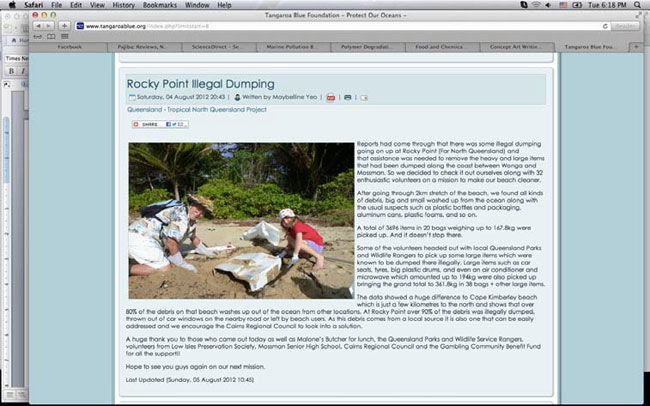 |
| Post media release on the Rocky Point clean up event |
Internship Activities
During the course of my internship, I helped with four full beach cleanup activities with local communities and wildlife park rangers (Rocky Point), aboriginal rangers (Cardwell), Marine Park endorsed schools (Lucinda) and governmental department personnel (Farnborough). The activities included preparation for the cleanup, advertisement and notification of the cleanup to get a good turn out, data analysis of debris collected from the cleanup, post media release, identification and tracking of certain items to the source and solution research. I also helped on the post cleanup media release for the Chili Beach cleanup including radio and TV interviews. I assisted with the teaching to aboriginal rangers on how to use the Cybertracker by simulating a cleanup event in the Djunbunji ranger camp. I was a volunteer for a social survey conducted in Port Douglas regarding plastic bags usage in stores as an effort to create a plastic bag free Port Douglas. And lastly we conducted two beach surveys along the beaches of Cape Kimberly and Port Douglas. I also had an additional project to work on which was to research on the weather balloons released in Australia and to find alternative materials or method for the current Styrofoam usage.
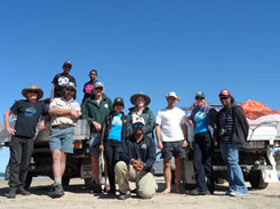 |
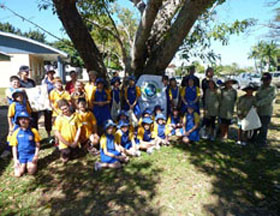 |
| Left: Clean up with Great Barrier Reef Park’s personnel and Queensland Parks and Wildlife rangers in Farnborough | Right: Education event with Marine Park Schools in Lucinda, Ingham |
During some of the beach cleanup and surveys (Farnborough and Cape Kimberly), I managed to collect some plastic pellet samples for my research by staying a few hours longer at the beach and looking for them with the help from Heidi. I also collected pellet samples at Mission Beach, which was along the way as we drove from Port Douglas to Cardwell.
Issues Worked On
Tangaroa Blue focuses on marine debris found on beaches. Under the current AMDI project, aboriginal rangers are considered a significant partner in tackling marine debris issues and its impact to the environment. It has been recorded that about 80 – 90% of all marine debris found happened to be plastic. It has also been documented that plastic debris caused severe impacts to marine wildlife. Considering the severity of marine plastic debris, it has become the main issue taken by Tangaroa Blue. And efforts such as data collection of plastic debris, collaboration with other organizations to study the effects of plastic debris and the spreading of awareness regarding the issue is ongoing.
Plastic pollution in the marine ecosystem is no longer an unknown myth but it surprises me sometimes that there are still people out there that are not aware of the issue or simply refuse to believe it. Most of the time, there are businesses or corporations or even government departments who are aware of the issue but do not think that they are posing much threat to the environment. We get hit with sentences such as “It will break down eventually” or “But our plastic are biodegradable”. There may be degradable plastics in existence now, but by no means are they biodegradable. They just break into smaller and smaller pieces but remains forever in the environment. These misleading campaigns of biodegradable plastic bags are encouraging more usage of these bags and shall further deteriorate the environment. We hope to spread awareness about this and hope that plastic bags can one day be substituted with reusable, paper, cornstarch or bamboo bags.
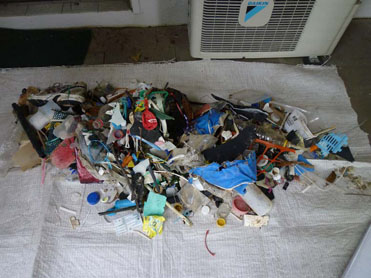 |
|
Rubbish collected at Port Douglas beach survey over a course of 100 m |
We find so many small fragments of plastic on the beach in all shapes, sizes and colours. Sometimes these pieces are so small that it is too difficult to spot or pick up. As we walk along the beach, we cannot help but feel that this is just a peek into our future, and that in five decades or so, the sand on beaches will be substituted by plastic fragments instead. We try to educate people that you do not have to throw rubbish into the ocean or by the beach for it to end up there. Litter anywhere and run off would carry them there for you. Hence, proper disposal of rubbish is just as important.
It was also great to see that rural communities are more proactive in environmental conservation compared to urban residences. There was no need to utilize empathy and the topic of health hazards toward humans. They treasure their wildlife enough that even if we presented no facts on plastic pollutions affects on humans, as long as it was threatening their wildlife, it was enough to call for actions. It made me realize that environmental education and awareness is extremely complicated for it is incredibly subjective and materials, activities and facts have to be prepared specially for each individual, community or group in order for it to be effective.
Finally, networking and cooperation play paramount roles in environmental conservation. But it is never easy to build connections and trust that is necessary in order to ensure a fruitful collaboration. Throughout my internship, I was introduced to, and worked with many parties. From corporations, volunteer groups, government departments, other non-profit organization groups, researchers, park and wildlife rangers, aboriginal ranger groups to media personnel and local stores. And it takes time and effort in order to create a comfortable working environment between parties. Sometimes, we may suffer setbacks such as difference in opinion, priorities and ways of addressing a problem. When working with sensitive groups, we also faced questions, which forces us to discuss sensitive topics.
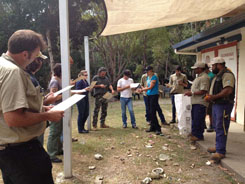 |
| Working with training rangers in Djunbunji Ranger Camp |
Marine conservation covers everything from marine debris to wildlife tracking and health. We can never be experts in everything, thus collaboration between different groups and organizations are always important. Hence, the setbacks and differences must never stand in the way of collaborations, which could offer much more benefits despite the obstacles. One of the best experiences I had was the privilege of working with the aboriginal rangers. They are truly passionate about their “country” (traditional ownership area) and will do anything to protect and preserve it. But most of them do not have much formal education and are often ignored by educational institutes regarding questions on sample analysis and so on. They wouldn’t mind working in the field and collecting data and samples, and would really appreciate feedbacks. This truly inspired me and I gladly offered to consult with them to the best of my ability should they have any technical questions regarding the environment. They have also offered to keep an eye out for plastic pellets and would send them to me as samples. Heidi is also determined to support them and connect them to her network of environment advocates. Because we all have a common passion for the environment, our collaboration shall continue for as long as possible.
Personal Thoughts
There will always be ignorance and evil in the world. But there’s also hope, kindness, love and brilliance. There will be times, where we will be faced with dead ends and never-ending problems but sometimes all that is needed is a little help, not too much, just a little and that would make the world a better place is what I observed throughout my internship.
The human race is ambitious, always reaching for the limit to surpass it. We make big plans and expect big results and would settle for nothing less. All of which is good, but sometimes when we turn towards the environment, it helps to be reminded that every little effort helps. And that by just making little changes or by making conservation activities a little bit easier and accessible, we can make all the difference in the world. Environmental efforts don’t have to be global or bring drastic changes, but it can start from a community or a single person and grow from there as Heidi has done. And from her, a movement started and it grew and shall continue to grow forward from now on.
Most importantly, I believe that as long as people are aware of the difference they made, the effort will continue and the passion will grow. Working with Heidi for three weeks showed me that people are willing to learn and take time out of their lives to conserve the environment. They just need a platform to do it. Just by organizing these activities, or by making efforts accessible to the communities, would encourage people to participate.
And as I mentioned before, it takes a collaboration of many parties to conserve the environment and I want to be a part of that. I have always wanted to bridge the academic world and the social world of the environmental field. But now more than ever, I want to help provide information and serve people such as Heidi and the rangers who are constantly working in the fields. I want to work side by side with them at times but more importantly be the support they need when it comes to science and technicality. In a field so diverse, there can never be a “we” and “them”, only us.
This internship has provided me with a clear idea of what I would like to work towards in the future and how to go about it. The wonderful opportunity of working with people of different age groups and backgrounds has boosted my confidence in communicating environmental facts. And as I communicate what I do in the lab and its significances to others, I become more and more conscious of the passion I have for science and the environment. With that, the communication becomes more honest and effective in my opinion.
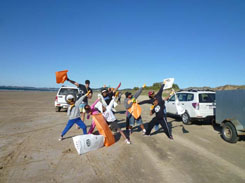 |
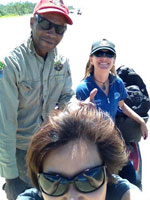 |
| Lastly, it’s important to know that conserving the environment doesn’t have to be a serious task, it can be FUN! | |